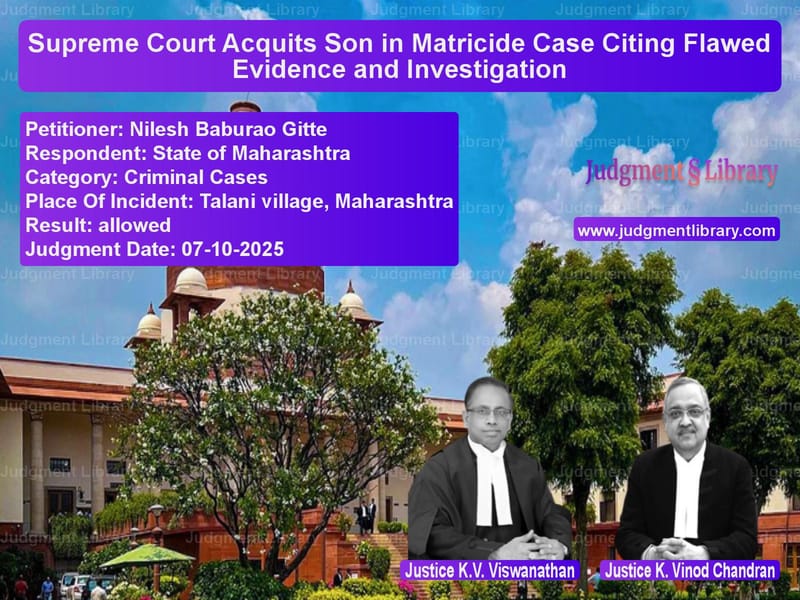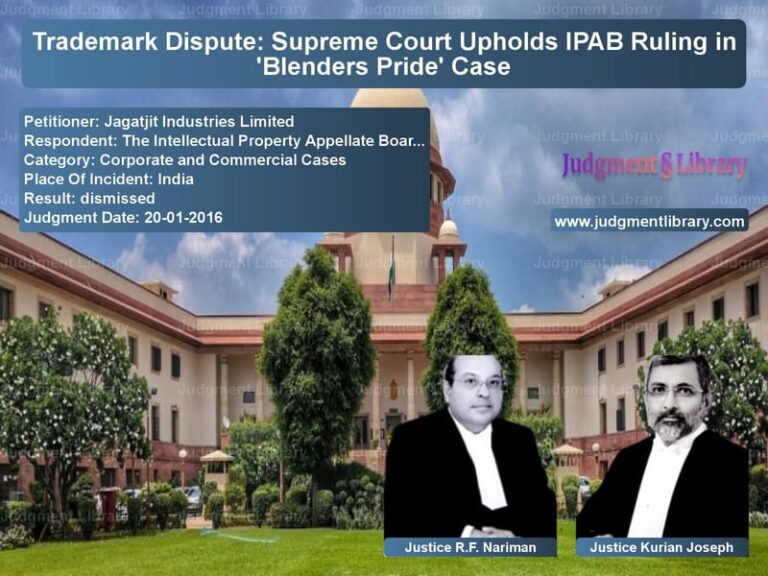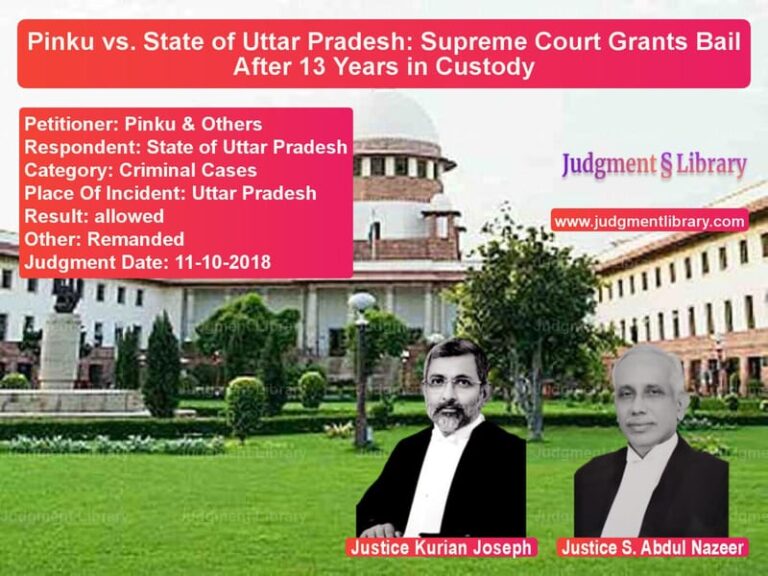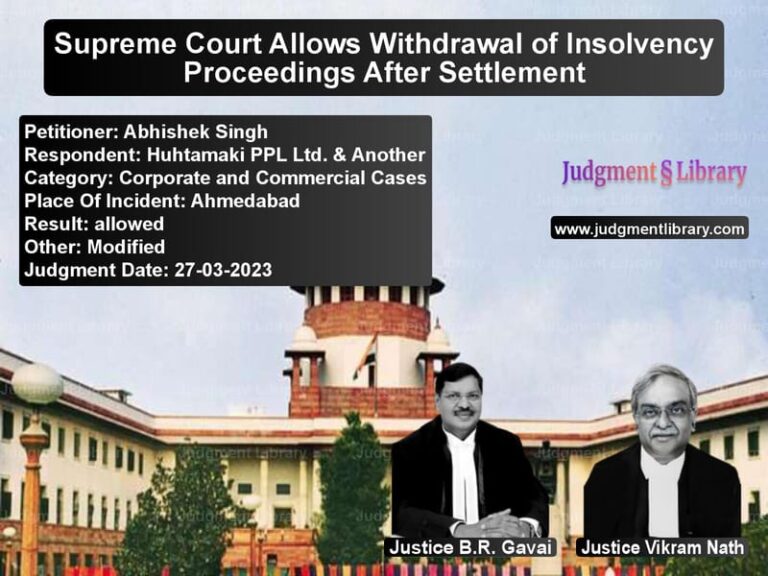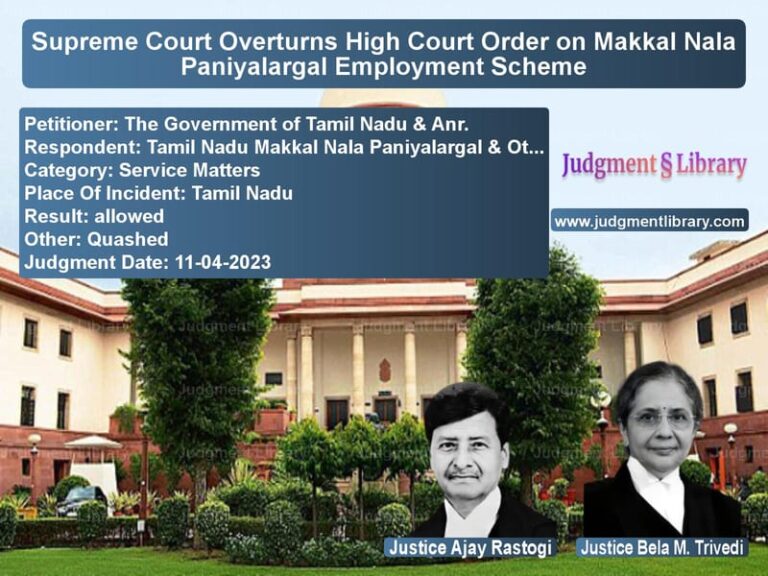Supreme Court Acquits Son in Matricide Case Citing Flawed Evidence and Investigation
In a dramatic turn of events that highlights the critical importance of proper investigation and evidence collection in criminal cases, the Supreme Court of India has acquitted a man convicted of murdering his own mother. The judgment delivered on October 7, 2025, exposes serious flaws in the prosecution’s case and raises fundamental questions about how circumstantial evidence should be evaluated in criminal trials.
The case involved Nilesh Baburao Gitte, who had been convicted by both the trial court and the Bombay High Court for the murder of his mother Sunanda (also known as Nanda Gitte). The prosecution’s case rested entirely on circumstantial evidence, with no direct witnesses to the alleged crime. What unfolded in the Supreme Court was a meticulous examination of each piece of evidence that ultimately revealed critical weaknesses in the case against the appellant.
The Prosecution’s Case
The prosecution had built its case around several key circumstances. According to their version, on July 22, 2010, police received information about a suspicious death in Talani village. When police officials reached the spot, they found that the last rites of Sunanda were being hurriedly performed. Upon inspection, they noticed strangulation marks on the neck and an injury on the back of the skull with blood oozing out. The police immediately stopped the cremation and began investigation.
The prosecution argued that Nilesh had motive to kill his mother to acquire her property. They relied on recovery of certain items at his instance, his alleged unnatural conduct in not reporting the death to police, and the fact that he arranged cremation in an open field behind his house rather than following proper procedures.
The Defense’s Arguments
Senior counsel Mr. K. Parmeshwar, representing the appellant, launched a comprehensive attack on the prosecution’s case. He argued that there was serious uncertainty about whether the death was even homicidal. Referring to the evidence of Dr. Salunke (PW-6) who conducted the postmortem, he pointed out that “the absence of the ligature mark on the backside of the neck is possible in cases of hanging and that in case of strangulation ligature mark would be present all around the neck.”
The defense also highlighted that the investigating officer had obtained a certificate from Vivekanand Hospital, Latur indicating that the deceased was suffering from schizophrenia, but this document was never exhibited at trial. This was crucial because, as the doctor testified, some injuries on the body could be possible if a person suffering from schizophrenia attempts suicide by hanging.
Regarding the recovery evidence, the defense argued that the witness (PW-2) was unreliable and had been planted by PW-3, who had serious property disputes with the deceased’s family. The defense contended that “PW-3 has a serious property dispute with the family of the deceased” and was actually the one who stood to benefit from Sunanda’s death, not the appellant.
The State’s Counterarguments
Mr. Adarsh Dubey, representing the State of Maharashtra, vehemently defended the conviction. He argued that the appellant’s conduct after the incident was highly unnatural. “Common course of human conduct would be that a son would raise a hue and cry if he sees his mother in an injured condition. It was only because the appellant was wanting to hastily cremate the mother, he did not raise any hue and cry,” he contended.
The State relied heavily on the principle established in Trimukh Maroti Kirkan vs. State of Maharashtra, arguing that when an offense like murder is committed in secrecy inside a house, the burden shifts to the inmates to give a cogent explanation. They also pointed to the FSL report which showed blood group ‘A’ on the nylon rope, matching the appellant’s blood group.
The Court’s Scrutiny of Medical Evidence
The Supreme Court conducted a detailed analysis of the medical evidence and found it seriously lacking. The Court noted that the doctor’s evidence created doubt about whether the death was homicide at all. The Court observed: “The candid admission of PW-6 that in the absence of ligature mark on the back side of the neck hanging cannot be ruled out and the further reinforcement that in strangulation ligature mark should be present all around the neck lead us to conclude that this is not a case where we can safely opine that the death was by homicide.”
The Court also noted that the certificate from Vivekanand Hospital showing the deceased had schizophrenia, though collected by the investigating officer, was never exhibited. The Court cited its earlier judgment in Ramaiah alias Rama v. State of Karnataka, stating that “even without formal proof thereto by the prosecution, it was always open for the defence to seek reliance on such an evidence to falsify the prosecution version.”
Mysterious Investigation Gaps
One of the most striking aspects of the judgment is the Court’s criticism of the investigation. The Court noted that there was a “mystery surrounding the genesis and origin of the prosecution case.” Despite multiple police officials reaching the spot where the first attempted cremation was happening, and despite a crowd being present, no investigation was conducted to determine who had organized that cremation.
The Court pointedly asked: “No leads from the crowd, who gathered there, have been picked out and nobody has been examined in Court. There is no evidence to show that the present appellant was present at the site of the first attempted cremation, or any of the relatives of the deceased.”
Contradictory Evidence on Residence
The prosecution’s entire case rested on the assumption that the appellant lived with his mother and therefore owed an explanation under Section 106 of the Evidence Act. However, the Court found that the investigating officer himself had stated that the appellant was residing in the house of Motiram Gitte on rental basis. This completely undermined the prosecution’s theory.
The Court rejected the State’s attempt to apply the principle from Trimukh Maroti Kirkan, stating: “Today in the teeth of the evidence of the Investigating Officer that the accused was a resident in the house of Motiram Gitte, it cannot be concluded that the accused resided with the deceased and was with the deceased at the time when she breathed her last.”
Unreliable Witnesses and Recovery
The Court found serious problems with the recovery evidence and the witnesses presented by the prosecution. PW-2, the panch witness, gave contradictory statements about how he reached the place of recovery and admitted that he couldn’t read Marathi but signed documents anyway. The Court noted that “the witness has materially contradicted himself and we have no doubt that he is taking enormous liberties with truth.”
Regarding PW-3, the appellant’s uncle who provided the motive theory, the Court found his evidence untrustworthy. His statement was recorded 50 days after the incident, despite his claim of visiting the police station the day after the death. The Court also noted his property disputes with the deceased, raising questions about his actual motives.
Acquittal of Co-accused
Significantly, the High Court had already acquitted the co-accused Balasaheb Gangadhar Gitte on the same evidence. The Supreme Court noted this as an important factor, stating that “the acquittal of the second accused-Balasaheb and the rejection of the evidence of PW-2 insofar as recovery of the nylon rope only reinforces our view.”
The Final Ruling
In its concluding observations, the Court invoked the famous caution about circumstantial evidence from Hanumant vs. State of Madhya Pradesh: “The mind was apt to take a pleasure in adapting circumstances to one another, and even in straining them a little, if need be, to force them to form parts of one connected whole; and the more ingenious the mind of the individual, the more likely was it, considering such matters, to overreach and mislead itself, to supply some little link that is wanting, to take for granted some fact consistent with its previous theories and necessary to render them complete.”
The Court ultimately held that “the courts below have fallen into a serious error in convicting the appellant on the basis of the evidence on record. Not only the tests laid down in Sharad Birdhichand Sarda (supra) have not been satisfied, recording the conviction based on the material on record would be disregarding the warning” about the dangers of circumstantial evidence.
The Supreme Court allowed the appeal, set aside the High Court’s judgment, and acquitted the appellant of all charges. The judgment serves as a powerful reminder of the fundamental principle that in criminal cases, the burden of proof remains squarely on the prosecution, and convictions cannot be based on assumptions, speculation, or incomplete evidence.
Petitioner Name: Nilesh Baburao Gitte.Respondent Name: State of Maharashtra.Judgment By: Justice K.V. Viswanathan, Justice K. Vinod Chandran.Place Of Incident: Talani village, Maharashtra.Judgment Date: 07-10-2025.Result: allowed.
Don’t miss out on the full details! Download the complete judgment in PDF format below and gain valuable insights instantly!
Download Judgment: nilesh-baburao-gitte-vs-state-of-maharashtra-supreme-court-of-india-judgment-dated-07-10-2025.pdf
Directly Download Judgment: Directly download this Judgment
See all petitions in Murder Cases
See all petitions in Bail and Anticipatory Bail
See all petitions in Fraud and Forgery
See all petitions in Custodial Deaths and Police Misconduct
See all petitions in Other Cases
See all petitions in Judgment by K.V. Viswanathan
See all petitions in Judgment by K. Vinod Chandran
See all petitions in allowed
See all petitions in supreme court of India judgments October 2025
See all petitions in 2025 judgments
See all posts in Criminal Cases Category
See all allowed petitions in Criminal Cases Category
See all Dismissed petitions in Criminal Cases Category
See all partially allowed petitions in Criminal Cases Category

